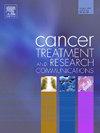韩国乳腺癌患者术中使用低能量 X 射线作为肿瘤床增量的放射治疗 (IORT) 的长期肿瘤学疗效
IF 2.4
Q3 Medicine
引用次数: 0
摘要
虽然术中放疗(IORT)用于加速乳房部分照射的使用正在增加,但关于其在亚洲人群中的有效性的研究并不多。在这项研究中,我们的目的是调查韩国患者接受低能量x线作为肿瘤床促进IORT的长期肿瘤预后。方法我们进行了一项II期、前瞻性、单臂试验,以评估接受IORT的乳腺癌患者的局部毒性和肿瘤预后,低能x射线作为肿瘤床增强(NCT02213991)。患者接受IORT作为肿瘤床的低能x射线(20 Gy)增强,然后进行全乳外束放疗(46 Gy)。诊断为早期乳腺癌或原位导管癌的患者适合进行乳房肿瘤切除术。Kaplan-Meier分析用于评估延长随访期的肿瘤预后。结果2014年8月至2016年9月期间,共有194例患者接受了IORT治疗。中位随访85.6个月,报告复发12例(6.19%),其中以同侧乳腺肿瘤复发(IBTR)为首发复发事件4例(2.06%)。5年和8年IBTR率均为2.1%(95%置信区间(ci), 93.8 - 98.9)。5年局部-区域无复发生存率(LRRFS)、无复发生存率(RFS)和总生存率(OS)分别为97.37%、96.32%和100%。结论:在延长的随访期间,我们通过低能x射线确定了IORT的肿瘤学安全性,作为肿瘤床的提高。本文章由计算机程序翻译,如有差异,请以英文原文为准。
Long-term oncologic outcome of intraoperative radiotherapy (IORT) with low-energy X-rays as a tumor-bed boost in Korean patients with breast cancer
Background
Although the use of intraoperative radiotherapy (IORT) for accelerated partial breast irradiation is growing, there are not many studies on its effectiveness specifically in Asian population. In this study, we aimed to investigate the long-term oncologic outcomes of Korean patients who received IORT with low-energy X-ray as a tumor-bed boost.
Methods
We conducted phase II, prospective, single-arm trial to evaluate the local toxicity and oncologic outcomes in breast cancer patients receiving IORT with low-energy X-rays as a tumor-bed boost (NCT02213991). Patients underwent IORT as a tumor-bed boost with low-energy X-rays (20 Gy) followed by external beam radiotherapy for whole breast irradiation (46 Gy). Patients diagnosed with early-stage breast cancer or ductal carcinoma in situ who were suitable for lumpectomy were considered eligible. Kaplan-Meier analysis was used to assess oncologic outcomes with an extended follow-up period.
Results
A total of 194 patients underwent IORT between August 2014 and September 2016 according to the protocol outlined in our study. During the median follow-up of 85.6 months, 12 cases (6.19 %) of recurrence were reported, of which 4 (2.06 %) were reported ipsilateral breast tumor recurrence (IBTR) as the first recurrence event. The 5- and 8-year IBTR rates were both 2.1 % (95 % confidence intervals (CIs), 93.8 – 98.9). The 5-year loco-regional recurrence-free survival (LRRFS), recurrence-free survival (RFS), and overall survival (OS) rates were 97.37 %, 96.32 %, and 100 %, respectively.
Conclusion
We identified the oncologic safety of IORT with low-energy X-rays as a tumor-bed boost in Korean patients during an extended follow-up period.
求助全文
通过发布文献求助,成功后即可免费获取论文全文。
去求助
来源期刊

Cancer treatment and research communications
Medicine-Oncology
CiteScore
4.30
自引率
0.00%
发文量
148
审稿时长
56 days
期刊介绍:
Cancer Treatment and Research Communications is an international peer-reviewed publication dedicated to providing comprehensive basic, translational, and clinical oncology research. The journal is devoted to articles on detection, diagnosis, prevention, policy, and treatment of cancer and provides a global forum for the nurturing and development of future generations of oncology scientists. Cancer Treatment and Research Communications publishes comprehensive reviews and original studies describing various aspects of basic through clinical research of all tumor types. The journal also accepts clinical studies in oncology, with an emphasis on prospective early phase clinical trials. Specific areas of interest include basic, translational, and clinical research and mechanistic approaches; cancer biology; molecular carcinogenesis; genetics and genomics; stem cell and developmental biology; immunology; molecular and cellular oncology; systems biology; drug sensitivity and resistance; gene and antisense therapy; pathology, markers, and prognostic indicators; chemoprevention strategies; multimodality therapy; cancer policy; and integration of various approaches. Our mission is to be the premier source of relevant information through promoting excellence in research and facilitating the timely translation of that science to health care and clinical practice.
 求助内容:
求助内容: 应助结果提醒方式:
应助结果提醒方式:


